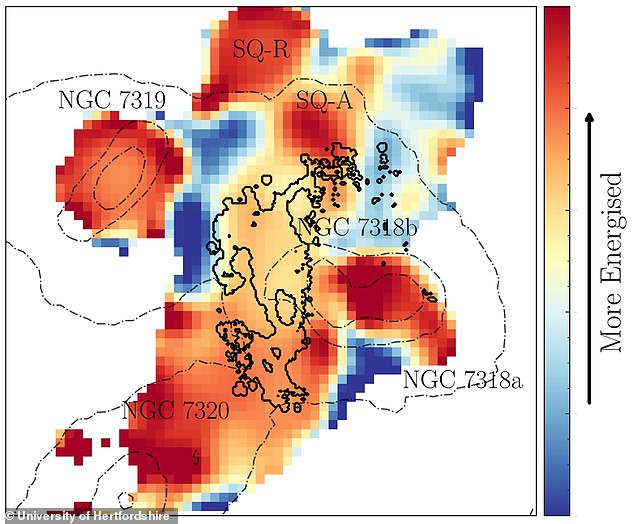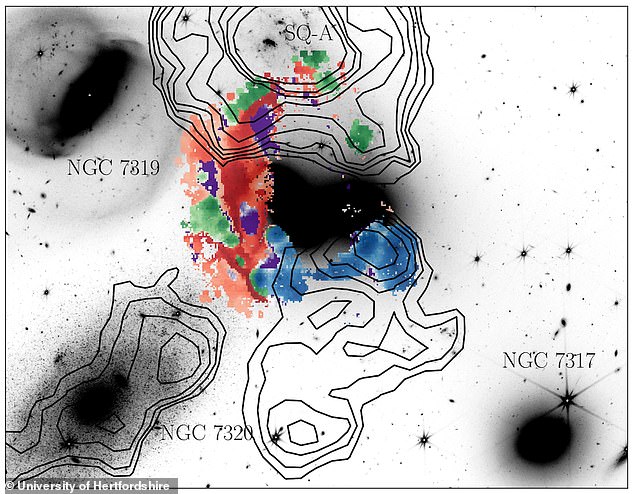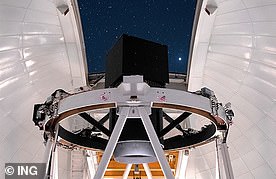Our galaxy colliding with a nearby neighbour is one of the gruesome scenarios of how our world could end.
Now, astronomers reveal what such a dramatic ‘smash-up’ event could look like.
The international team of scientists have captured a collision between two galaxies located about 290 million light-years away from Earth.
One galaxy, called NGC 7318b, travelled towards the other at 2 million mph (3.2 million km/h), pulled by intense gravitational forces.
The collision between the pair sparked an immensely powerful shock akin to a ‘sonic boom from a jet fighter.’
According to the researchers, the encounter released enough energy to rip apart electrons from atoms.
‘This high-speed collision is causing havoc in NGC 7318b, particularly with respect to its reserves of hydrogen gas, which are being stripped off,’ they said.
‘It is likely that the formation of new stars in this galaxy will be greatly slowed down since it is principally hydrogen that fuels this process.’


The collision was detected using the first observations from the £16.7 million William Herschel Telescope Enhanced Area Velocity Explorer (WEAVE) in La Palma, Spain, as well as the Low-Frequency Array (LOFAR) radio telescope in the Netherlands.
The dramatic impact happened in Stephan’s Quintet, a nearby galaxy group made up of five galaxies – NGC 7317, NGC 7318a, NGC 7318b, NGC 7319 and NGC 7320.
‘NGC 7318b is coming into the galaxy group from behind, and is colliding with NGC 7318a,’ Professor Gavin Dalton, WEAVE principal investigator at the University of Oxford, told MailOnline.
‘This is happening because 7318b is falling into the group, most likely as it has been pulled in by the combined mass of the other galaxies.
‘Most of the stars in the galaxies are largely unaffected by this.’
The light from these galaxies has taken about 285 million years to reach us, so we’re seeing this as it happened 285 million years ago, Professor Dalton added.
‘The collision itself would probably last about 10,000 years, given the relative speeds and the typical sizes of galaxies,’ he told MailOnline.
First observed nearly 150 years ago, Stephan’s Quintet is famous for appearing as angelic figures at the beginning of the 1946 Christmas film ‘It’s a Wonderful Life’.


‘Since its discovery in 1877, Stephan’s Quintet has captivated astronomers,’ said lead researcher Dr Marina Arnaudova at the University of Hertfordshire.
‘It represents a galactic crossroad where past collisions between galaxies have left behind a complex field of debris.’
‘Dynamical activity in this galaxy group has now been reawakened by a galaxy smashing through it at an incredible speed of over 2 million mph (3.2 million km/h), leading to an immensely powerful shock, much like a sonic boom from a jet fighter.’
Any aliens that might exist in the galaxies are likely to have been unaffected by the collision due to the vast distances between stars, Dr Arnaudova told MailOnline.
The observations reveal previously unobserved behaviour of the so-called ‘shock front’, the leading edge of the collision’s shock wave.
As the shock moves through pockets of cold gas, it travels at hypersonic speeds – about 980,000 mph or 440km/s, which is several times the speed of sound in Stephan’s Quintet.
This makes the shock powerful enough to rip apart electrons from atoms, leaving behind a glowing trail of charged gas, as seen with WEAVE, Dr Arnaudova said.
However, when the shock passes through the surrounding hot gas, it becomes much weaker and its destructive capability weakens.

‘Instead of causing significant disruption, the weak shock compresses the hot gas, resulting in radio waves that are picked up by radio telescopes like LOFAR,’ said Soumyadeep Das, PhD student at the University of Hertfordshire.
The findings, published today in Monthly Notices of the Royal Astronomical Society, give a glimpse of what could ultimately happen to our Milky Way.
Astronomers say there’s a 50 per cent chance the Milky Way will collide with the neighbouring Andromeda galaxy in the next 10 billion years.
While this sounds like bad news, a 50/50 chance is actually less certain than scientists previously assumed.
If and when the collision occurs, planets and stars in the two galaxies would be flung together – creating one super galaxy known as ‘Milkdromeda’.
There’s a very small chance our sun would collide with another star, which could alter our position in relation to the sun and threaten life on Earth – if it still exists by then.
‘While the Milky Way-Andromeda collision may lead to significant changes in the galactic structure, again it’s unlikely that Earth would be directly affected by the collision itself,’ Dr Arnaudova told MailOnline.
‘The biggest threats to Earth would more likely come from the sun’s evolution, as it would move out of its stable phase in a few billion years, but still long before the galactic merger.’

Eric Bell, professor of astronomy at the University of Michigan who wasn’t involved in the new study, said galaxy collisions would only be dangerous because of a slightly increased chance of stars colliding with each other.
Even a near collision with another star – a ‘close pass’ – would affect our orbit, which Professor Bell said would be ‘very bad’.
‘The close pass changes the orbit, bringing us closer to the sun, or bringing us further away,’ he told MailOnline.
‘What our fate would be depends on exactly how our orbit changed.
‘So we would either escape the solar system (in which case we’d slowly freeze to death over months).
‘Or we’d get cooked by the sun (which may be very fast, or take months, depending on the orbit we ended up in).’
As well as giving new insights into millions of galaxies across the universe, experts hope WEAVE could reveal more about our own Milky Way galaxy.
The £16.7 million mapping device has largely been funded by the UK’s Science and Technology Facilities Council, as well as major contributions from the Netherlands, Spain, France and Italy.
The international team described the level of detail in these first WEAVE images as ‘fantastic’ and ‘just a taste of what is to come’.
‘As well as the details of the shock and the unfolding collision that we see in Stephan’s Quintet, these observations provide a remarkable perspective on what may be happening in the formation and evolution of the barely resolved faint galaxies that we see at the limits of our current capabilities,’ Professor Dalton said.

